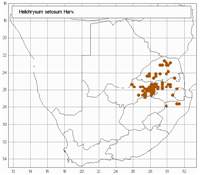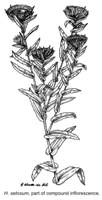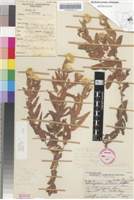Origin of name:
Bohloko, phefo-ea-thaba, toane-balingoane. (SS)
Diagnostic characters:
Bright yellow bractsLarge solitary heads
Description:
Herbaceous perennial or subshrub, branched from the base, stock with vegetative buds or small leaf tufts, stems up to 1 m tall, but often only c. 500 mm, woody, brittle, glandular-setose, uppermost parts sometimes white-cobwebby as well, closely leafy. Leaves mostly 20�50 x 10�20 mm, slightly smaller on the inflorescence branches, mostly oblong-ovate often becoming elliptic-lanceolate to lanceolate on the inflorescence branches, obtuse to acute, mucronate, base broad, more or less cordate-clasping, both surfaces and margins glandular-setose, margins and sometimes the midline above sometimes woolly as well, young leaves sometimes cobwebby all over. Heads heterogamous, 10�12 (�14) mm long, about double that across the radiating bracts, depressed-globose, solitary at the tips of long leafy branchlets corymbosely arranged. Involucral bracts in c. 9 series, graded, imbricate, inner much exceeding the flowers, glossy, yellow often overlaid pale brown outside. Receptacle shortly honeycombed or nearly smooth. Flowers c. 480�1 100, 65�160 female, 400�950 homogamous. Achenes 1 mm long, glabrous. Pappus bristles many, equaling the corolla, tips barbellate, shaft scabrid, base with patent cilia cohering or not.
Flowering May to August.
Distribution:
Widespread in the Limpopo from the Soutpansberg south to Potgietersrust in the east and the Waterberg in the west, then widespread on the Highveld, and reaching Parys and Vredefort in the Free State and Newcastle, Dundee, Ngotshe and Klip River districts in KwaZulu-Natal. Also in Zimbabwe and Malawi.
Grassland and Savanna Biomes.
Notes:
The name has been much misused. The species is characterized by its bushy habit, glandular-setose leaves mostly ovate or oblong-ovate, obtuse or acute, and heads solitary at the tips of long leafy branches arranged in a corymbose panicle; these branches are glandular-setose like the leaves; any white woolly hairs are confined to the area immediately below the heads and to the leaf margins and main vein. Although the leaves under the heads are a little smaller than those further back down the branches, they are nevertheless relatively large and crowded, often equaling or exceeding the involucre, and contribute to the very leafy appearance of the compound inflorescence. The arrangement of the heads alone will immediately distinguish H. setosum from H. cooperi, with which it is frequently confused: H. cooperi has a well-branched compound inflorescence, and furthermore the main stem leaves are usually at least shortly decurrent. H. tongense and specimens of H. mutabile lacking wool on the leaves have also been confused with H. setosum, but the leaves on the inflorescence branches are reduced and distant near the heads, not close-set and relatively large as in H. setosum.
O. Kuntze remarked of his varietal name 'a form with somewhat woolly leaf margins as in H. fulgidum'; it is not worth upholding.
Taxonomy:
Literature:
Helichrysum setosum Harv. in F. C. 3: 231 (1865); Moeser in Bot. Jb. 44: 337 (1910); Brenan in Mem. N. Y. bot. Gdn 8,5: 474 (1954); Hilliard, Compositae in Natal 246 (1977).
Type:
Lectotype: Gauteng, on the Vaal River, May, Burke 98 (TCD; BM; K; Z; fragment PRE, isolecto.).
Synonym(s):
Gnaphalium setosum (Harv.) O. Kuntze, Rev. Gen. Pl. 3,2: 154 (1898).
G. setosum var. hoffmannii O. Kuntze, Rev. Gen. Pl. 3,2: 154 (1898). Type: KwaZulu-Natal, Glencoe, Highlands Station, Kuntze (K).
Vouchers:
Acocks 21029 (PRE); Hilliard & Burtt 14423 (E; K; M; MO; NU; PRE; S); Pegler 1772 (PRE); Strey 3756 (BM; K; M; PRE); Vahrmeijer 1548 (PRE).

